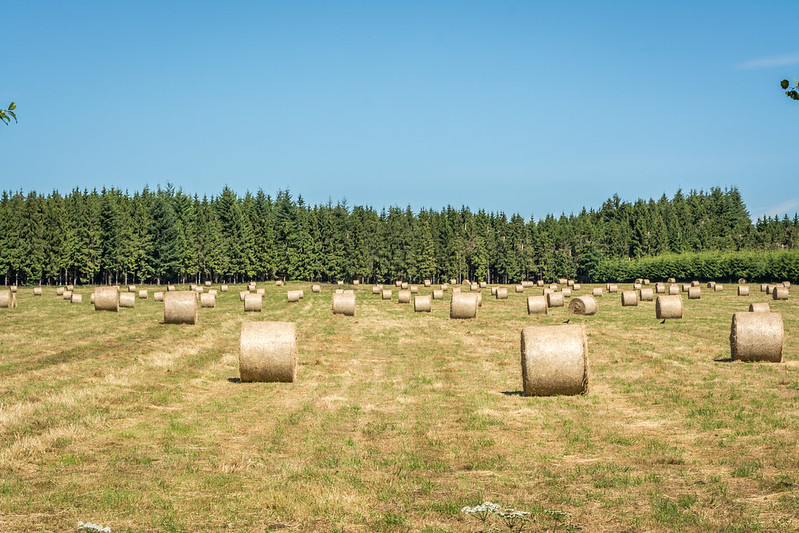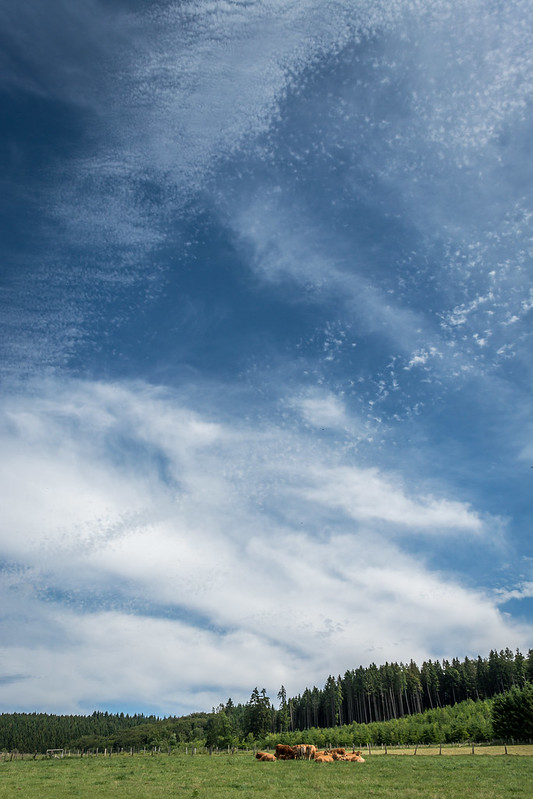The track follows this little ravine called "Wiltz". I am sure there are trouts here.

In the Luxembourg side, before Belgium, the main attraction is four tunnels piercing the hills.

This is the track as recorded by Sports-tracker, allez-retour the same.
It is not easy to spot the actual border between the two countries. Almost the only sign is the change of the surface, smooth tarmac on the Luxembourg side and a bumpier cement surface on the Belgian side.

Also the agricultural activity is somewhat different. On Luxembourg side there is lots of cereal fields like this barley (Hordeum vulgare, ohra) field. Barley has four times more of vitamin B1 than brown rice.

On the Belgian side, the predominant agricultural activity is cattle herding, for meat. Indeed we tasted extremely tender beef later the same day in Houffalize. See the bovines in the last photo of theis article.
Few km before Bastogne we spotted this purple plant, Chamerion angustifolium. In Britain it is called Rosebay Willowherb and in America Fireweed. Maitohorsma in Finnish, Épilobe en épi in French, Mjölke in Swedish, Sigurskúfur in Icelandic and 柳兰 in Mandarin.

Rosebay willowherb is particularly interesting, because it is important part of the cultural landscape in Central and Northern Finland, where it covers sometimes large areas and is the symbol of Southern Ostrobothnia region. In Luxembourg it is not rare but not very common either. Wherever there is empty areas, for example because of construction or forest fire, Fireweed colonizes the space very quickly. The seeds remain viable in the soil for many years. Young shoots of Fireweed can be used in salads and are good source of vitamin C. Older leaves become bitter. Also roots can be used as food. In Alaska Fireweed is used for candies, syrups, jellies, and even ice cream. In Russia, the leaves are used as tea substitute. In the traditional Austrian medicine the plant is used internally as tea for treatment of disorders of the prostate, kidneys, and urinary tract.
Just before arriving to Bastogne, on the right hand side there is something interesting: the Memorial of Mardasson and the brand new War Museum. Unfortunately the War Museum was closed on Monday, so we didn't visit it, but what I have heard, it is very interesting. Entrance fee is 12 euros for adults. There are different discount policies for families and groups, and even the Spuerkees Zebra card owners get 3 euro discount. In Bastogne there is another war museum, the 101st Airborne museum Le Mess. We must come back soon.
General view to the Memorial of Mardasson

The memorial honours the memory of the 76,890 American soldiers who were wounded or killed during the Battle of the Bulge (Battle of the Ardennes). The Latin inscription on the memorial is LIBERATORIBVS AMERICANIS POPVLVS BELGICVS MEMOR IV.VII.MCMXLVI (The Belgian people remember their American liberators – 4th July 1946).

Thank you America for your sacrifice!

From the Memorial we turn to the North, to RAVeL, ancient railway line number 163, converted into cycling track. It goes from Bastogne to Gouvy, a railway hub located close to the northern corner of Luxembourg. This track we ride until Bourcy and take another former railway side track to Houffalize.
Most of the old railway stations are private houses now. Here is one example:

The history of the Battle of Bulge is everywhere. Here is a small, but important monument. The monument was erected for the memory of 101 airborne division that heroically defended against much stronger German troops in December 1944 in very tough conditions in freezing temperature of -20 Celsius.

The track from Bastogne to Bercy (and possibly up to Goyvy) is excellent, smooth and suitable for in-line skating, also for beginners, since there are practically no down hills.

Feed for cattle for the long winter months. How much does one roll cost?

This is the high point of the whole trip! Heracleum mantegazzianum, commonly known as Giant hogweed, kaukasianjättiputki in Finnish, Jätteloka in Swedish, Hiid-karuputk in Estonian, Tröllahvönn in Icelandic. This plant is PHOTOTOXIC, meaning that the sap of giant hogweed causes phytophotodermatitis in humans, resulting in blisters, long-lasting scars, and—if it comes in contact with eyes—blindness. If you get the sap on your skin, cover it as soon as possible, since in sunlight your skin start to burn. It is native in Caucasus area and Central Asia, but was introduced to Europe for ornamental reasons. And indeed, it is an impressive plant since it can grow up to 5 meters tall. The one we saw was 2 meters. It belongs to so called invasive species, that are actively fought against in many countries.

Bourcy is a small town some 10 km North of Bastogne. It has seen better days. There is an interesting restaurant/coffee shop, La Taverne Villageoise, but unfortunately it was closed. Maybe they have resting day on Monday.

Traditional Belgian farmhouse.



The side track to Houffalize is a downhill, a looooooong one, real joy to ride and beautiful. Coming back from Houffalize is uphill, but very gentle, also a great pleasure, and you don't need to do it hungry.

Houffalize is a lovely small town in the middle of the Ardennes. It was a strategic location during the Battle of the Bulge. Generals Montgomery and Patton met here, Montgomery coming from the north and Patton from the south, in their counter-attack against the German forces remaining in the area. Other than war history, it is famous for mountain bike tracks and world championships, international popular marching events, amusement park for kids, hospitality and local meat products.

Houffalize is located by the river Ourth, or more specifically its tributary "Ourthe oriental", also good for canoeing in Spring time.

The Church of Sainte Catherine of Alexandria (Katariina Aleksandrialainen). Catherine was a princess, who became a Christian around the age of fourteen, and converted hundreds of people to Christianity. Over 1,100 years following her martyrdom, St. Joan of Arc identified Catherine as one of the Saints who appeared to her and counselled her. As a young adult, Catherine visited the Roman Emperor Maxentius, and attempted to convince him of the moral error in persecuting Christians for not worshipping idols. The emperor arranged group of the best pagan philosophers and orators to dispute with her, hoping that they would refute her Christian arguments, but Catherine won the debate. Several of her adversaries, conquered by her eloquence, declared themselves Christians and were at once put to death. Catherine was then imprisoned, during which time over 200 people came to see her, including Maxentius' wife, the Empress; all converted to Christianity and were subsequently martyred. Upon the failure of Maxentius to make Catherine yield by way of torture, he tried to win the beautiful and wise princess over by proposing marriage. The saint refused. The furious emperor condemned Catherine to death on the spiked breaking wheel, but, at her touch, this instrument of torture was miraculously destroyed. Maxentius finally had her beheaded in 305 A.D.

This is the tourist information office of Houffalize. It is open every day from 9:00 to 16:30 with a half an hour break at 13:00.

This is Cafe de Rallye, maybe not the best restaurant in town, but freindly, and with extremely tender beef.

Don Esaias like exotic food, so he ordered saté (satay). Saté is an Indonesian dish of chicken in peanut sauce. White cakes in the corner of the plate are deep fried crackers called krupuk or kroepoek. They are served in all Chinese restaurants in Europe. Europeans think it is typical Chinese food, which is nonsense. I call it Chinese bread, which is nonsense as well.

This mademoiselle took orders and served food. She didn't speak much English, but Don was translating.

Typical Belgian multitude of signs.

Last but not least, Alba digitalis purpurea, a rare white variety of Digitalis purpurea. Foxglove in English, sormustinkukka in Finnish. More information on this beautiful, but POISONOUS plant in an earlier blog entry HERE.

A dead tree seen on the way back to starting point.

Unusual clouds hovering over beef cattle.

No comments :
Post a Comment